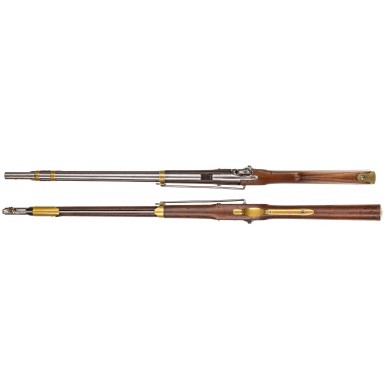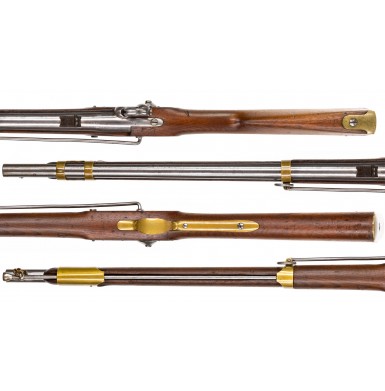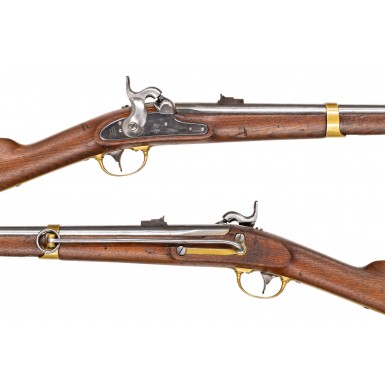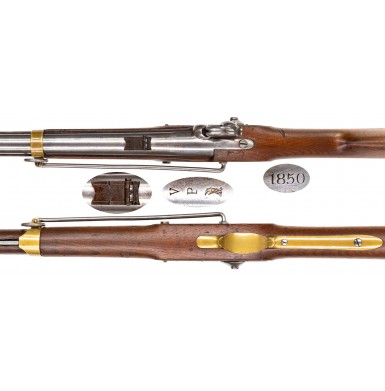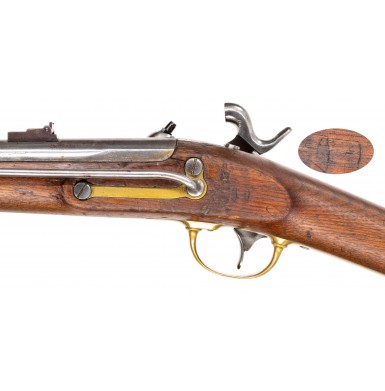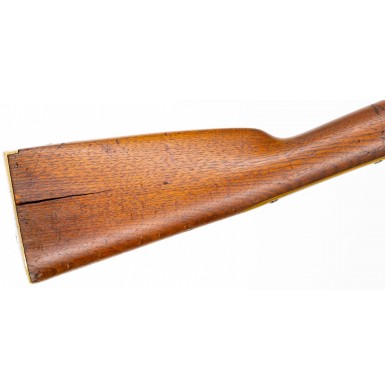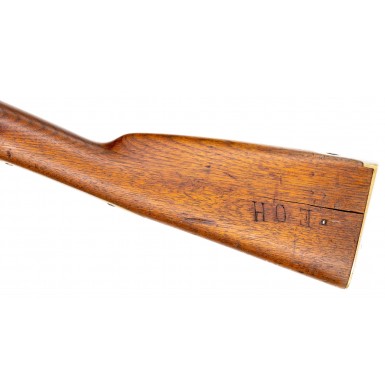Extremely Rare Complete and Correct Rifled & Sighted US Model 1847 Cavalry Carbine
- Product Code: FLA-3929-SOLD
- Availability: Out Of Stock
-
$5,750.00
In early 1847 the US Board of Ordnance met to evaluate three new patterns of “musketoons” that had been produced at the Springfield Arsenal during 1846. The designs had been on the drawing board since at least 1844, but the model guns were not prepared until late in 1846, probably because of other more important manufacturing going on at the Springfield Arsenal. These three pattern guns would be adopted and approved by the Ordnance Department as the US Model 1847 Sappers & Miners (Engineers) Musketoon, the US Model 1847 Artillery Musketoon and the US Model 1847 Cavalry Carbine.
All three patterns were quite similar, with minor differences in their furniture and features that adapted them to the specific needs of the branch of service that they were to be issued to. Both the Sappers & Miners Musketoons and the Artillery Musketoons had iron furniture, were equipped with sling swivels for carry by men on foot, used conventional ramrods and were capable of mounting a bayonet. The Sappers & Miners Musketoon accepted a large, brass handled saber bayonet based upon the US Model 1832 Foot Artillery Sword and the Artillery Musketoon accepted a standard US Model 1835 Socket Bayonet. The Cavalry Carbine by contrast was designed to be slung from a sling bar and ring system for a mounted man, and this by the definitions of the time made it a “carbine” and not a “musketoon” even though all three models of guns were short barreled and “musket bore”. The cavalry carbine alone had brass furniture, a captive ramrod and had no provision to accept a bayonet.
In all major features the guns were nearly identical, being single shot percussion muzzleloaders with an overall length of forty-one and one-sixteenth. The guns had a nominally twenty-six inches long, round, smoothbore barrel of .69 caliber which was the standard “musket bore” of the period, thus the terminology “musketoon”, a short barreled long arm of musket caliber. The barrels were secured to the stocks with a pair of flat, spring retained barrel bands, with the upper band being double strapped. The locks were all identical, being smaller versions of the US Model 1842 percussion lock then in use on the US Model 1842 infantry musket upon which the guns were based. As noted, the primary differences in the three models lay in the furniture, carrying systems, ramrod systems and type of bayonet mounting systems, if any, that were used on the guns. Additionally, the barrel of the cavalry musketoon was actually one-sixteenth of an inch longer than the two musketoons, being twenty-six and one-sixteenth in length instead of twenty-six inches.
While the family of US Model 1847 “musketoons” originally contained only three models, within a decade no less than ten different variants existed, due to modifications, design improvements, and refitting of some of the guns for other service. The family of arms went into production in 1847, with the first guns being completed and accepted into stores during that calendar year being a pair of Model 1847 Cavalry Carbines and 200 US Model 1847 Sappers & Miners Musketoons. The family of arms remained in production for nearly a decade at Springfield, with the last guns produced being thirty-three of the Sappers & Miners Musketoons, which were delivered in 1856. During the production run a total of 10,033 Model 1847 carbines and musketoons of all varieties were manufactured, with 1,030 being Sappers & Miners Musketoons, 3,210 being Artillery Musketoons and 5,802 being Cavalry Carbines. Despite being the largest part of Model 1847 production, today it is uncommon for collectors to find Model 1874 Carbines in their original “as issued” arsenal configuration. This is because the large majority of the cavalry carbines were altered in some way by the end of the 1850s, with most eventually being converted to conform to the “artillery carbine” pattern, which was really intended for use as a “cadet musketoon.” Many of the Sappers & Miners Musketoons were similarly converted to this new purpose as well.
The design for what would become US Model 1847 Cavalry Carbine was actually approved in 1844 by the Secretary of War and was referred to as a “dragoon carbine”, with the specification calling for it to be “similar to the Artillery Musketoon” and equipped with a “swivel ramrod” and “swivel bar to sling the arm on horseback”. The carbine was intended to replace the variety of breech loading Hall carbines then in use by the 1st, 2nd & 3rd US Dragoons. From a technological standpoint, it would appear that this was a huge step backwards, moving from a breechloading weapon to a muzzle loading weapon, and it probably was. Realistically it was probably more indicative of the very traditional attitude of the Ordnance Department that was biased against most breechloading arms as being wasteful of ammunition due to their higher rate of fire. The department also probably preferred the simpler and less expensive muzzleloading carbine for its fiscal frugality in construction and manufacture.
The first Model 1847 Cavalry Carbines were authorized to be issued to the 1st & 2nd US Dragoons in April of 1849, to start replacing the Hall carbines in service at that time. However, the first major shipment of cavalry carbines would not occur until March of 1851, when 500 of the carbines were shipped to New Mexico to supply the US Dragoons. As originally manufactured and issued the gun was a single shot, .69 caliber smoothbore, percussion ignition muzzle loading carbine with captive ramrod that operated on a swivel mechanism. The guns were brass mounted with a brass buttplate, triggerguard, side plate and pair of brass barrel bands. The upper band was double strapped, similar to that of the US Model 1841 Mississippi Rifle, but the forend of the carbine extended beyond the barrel band and came to a rounded end two and half inches from the muzzle. The upper band was secured by a steel band spring. The lower band was secured through a threaded lug that attached to the nine and half inch steel sling bar on the reverse of the carbine, that terminated at the side plate and rear lock mounting screw. A steel sling ring was suspended from the sling bar, to which the trooper could attach the snap hook of his carbine sling. A three-eights-inch stud was brazed under the barrel, three-quarters of an inch from the muzzle, from which the two curved, pivoting arms that secured the captive ramrod were slung. The lock was of the traditional design with only a half cock and a full cock notch, and no “safety” notch. The standard markings on the guns included a vertical three-line stamping on the tail of the lock behind the hammer which read SPRING / FIELD / (Date) and with a spread-winged American eagle with a shield in its breast, surmounting the letters U S, forward of the hammer. The barrel was marked with the date of manufacture on the breech plug tang and additionally received the standard Springfield Arsenal V / P / Eagle Head proof marks on the upper left quadrant of the breech. The buttplate tang was stamped U.S. and the counterpane of the stock was stamped with the cartouches of Springfield Armory inspectors and the Master Armorer.
Almost immediately after being issued, complaints began to come in from the field from the men who had received this new carbine. The deficiencies in design were myriad, and while some were things that could be fixed easily, the reality was that this gun was obsolete before it was issued and replaced a much more practical carbine for mounted use. From a military standpoint, the biggest complaints were that the light weight of the gun resulted in heavy recoil and the short, smoothbore barrel was quite inaccurate. From a practical standpoint, the gun tended to unload itself when carried muzzle down from the sling on horseback, as the round ball was simply jostled out of the barrel by the movement of the horse. This same problem occurred with the ramrod, which had no retention system in the stock, so it would vibrate loose and come out of the ramrod channel, resulting in damaged and lost ramrods simply from riding the horse. On top of that, the percussion caps often bounced off the cone (nipple) and were lost due to vibration from the horse. The only way to carry the carbine with a cap on it was to lower the hammer onto the cap, a good way to end up with an accidental discharge if the hammer were snagged and then released. If the gun was carried at half cock, there was more than enough room between the hammer nose and the cone for the cap to bounce off.
In 1851 the Ordnance Department announced modifications to resolve the cap and ramrod problems. The initial fix for the ramrod was to retrofit a “spoon” or friction retainer spring in the stock, as was done for the artillery and engineering musketoons. It was subsequently suggested that the problem could be resolved by increasing the length of the ramrod about one-half inch. Over the next couple of years, many of the existing cavalry carbines were modified by the addition of the spoon, or the addition of the new longer ramrod, or in some cases both. However, some were never modified with either upgrade. The solution for the percussion cap problem was to add a third “safety” notch to the tumbler. This new notch, forward of the half cock notch, allowed the sear to engage the tumbler at a point where the hammer was barely above the cone, high enough not to touch the percussion cap, but low enough to make sure the cap did not fall off the cone. To my knowledge, this is the only US arsenal produced percussion arm to incorporate three notches in the tumbler. As with the ramrod improvement, not all the guns were modified, and today they are found with and without the 3rdtumbler notch. Even with the improvements performed during 1851 and 1852 on many of the previously produced carbines, and supposedly incorporated into those yet to be produced, the carbines continued to perform poorly in the field, and were universally despised by the men who carried them, as well as their officers. Probably the most damning commentary came from Major William Anderson Thornton, whose “WAT” cartouche is well known on US martial arms. Thornton would eventually serve as the head of the Ordnance Department for the Department of New Mexico and would be the Chief of Ordnance at the New York Arsenal at Governor’s Island from just before the Civil War until his death in 1866. However, during 1855 and 1856 he was serving in the field in Texas, and from there he wrote a scathing condemnation of the Model 1847 Cavalry Carbine on February 16, 1856, which read in part:
“It is very severe in recoil and wants range and accuracy of fire. It cannot be carried loaded, because the charge is shaken out by the movement of the horse. It is loaded with much difficulty when mounted, and becomes quickly unserviceable by the breaking of the swivel, and loss of the ramrod and tumbler screw, and by the battering of the muzzle when carried in the bucket. The men have no confidence in the arm.” (emphasis added)
By the time of Anderson’s letter, the Model 1847 Cavalry Carbine was already being replaced in many US Dragoon companies with new Sharps breech loading carbines, and their accompanying US Model 1842 pistols were being replaced with Colt Dragoon percussion revolvers. Many of the cavalry carbines were returned to various arsenals around the country as they were replaced in the field with more modern breechloaders. Since the guns were considered obsolete, other uses for the carbines were found. During 1858 and 1859 some 630 of the cavalry musketoons were altered to “artillery” musketoons by removing the sling bar and swivel rammer system, adding a conventional ramrod and sling swivels and a stud to accept the current US Model 1835 pattern .69 socket bayonet. These newly minted “artillery” carbines were then sent to the various states as “cadet musketoons”, due to the fact that there were no more US Model 1841 or US Model 1851 Cadet Muskets in inventory. In the Ordnance Department’s typical parsimonious way, they kept looking for ways to utilize the unpopular carbine, and during fiscal year 1859 two Model 1847 Cavalry Carbines were modified at the Springfield Arsenal by rifling them for use with elongated ball (Minié) ammunition and adding US Model 1858 3-leaf rear sights. The unpopular swivel rammers were also removed and replaced by a rammer secured by a chain with a sliding ring on the rammer's shaft, that had a tulip shaped head, cupped for the elongated ball ammunition. The guns were further modified by drilling a hole under the buttplate and adding an 8-ounce lead weight in the butt to help minimize felt recoil and to improve the overall feel and balance of the carbine. Reports from Springfield claimed that the newly modified carbines performed “satisfactorily” at 400 and 500 yards. As a result, some 344 of the carbines were so modified during 1859 at Frankford Arsenal, using sights manufactured at Springfield. Of those 344 altered carbines, 100 were subsequently sent to the firm of Merrill, Latrobe & Thomas, where they were further modified and altered to breechloaders by the Merrill system. That left only 246, including the two Springfield Arsenal sample carbines, rifled and sighted US Model 1847 Cavalry Carbines in their original muzzle loading configuration.
Despite their herculean efforts to make lemonade out of lemons, the Ordnance Department started the process of disposing of the Model 1847 cavalry carbines during 1860. Documents indicate that the Model 1847 carbines at the Saint Louis Arsenal were sold to A. Hitchcock of New York, who was an arms dealer. At least 30 other Model 1847 cavalry carbines were sold to Delaware Kemper of Alexandria, VA. Kemper would organize the Alexandria Light Artillery in March of 1861 and serve as their Captain at the First Battle of Bull Run. This unit would later be merged into the 18thBattalion of Virginia Heavy Artillery, with Kemper promoted to Major. Even though there was an active attempt to rid the US military of the Model 1847 Cavalry Musketoon, by the end of the 1862, there were still nearly 1,000 in service in the field, as the 31 December 1862 Ordnance Returns show 947 of the guns in the hands of active regiments. The two regiments that showed the most Model 1847 Cavalry Carbines on their returns were the 1st Texas Cavalry (US) with 410 and the 1st New Mexico Cavalry (US) with 301. The guns were also in the field with the 5th Kansas (27), 5th Missouri State Militia Cavalry (51), 12th Missouri State Militia Cavalry (138), and the 13th Missouri State Militia Cavalry (20). Other carbines were in storage at that time as well, as a 17 May 1862 request for artillery carbines from Fort Delaware was responded to by General James Ripley (Chief of Ordnance), that no artillery musketoons were available, but that cavalry carbines (either rifled or smoothbore) were available. However, he noted that these guns could not accept bayonets.
The modified US Model 1847 Rifle & Sighted Cavalry Carbine offered here is one of those extremely rare, 100% complete and correct examples of these scarce guns. The lock of the gun is marked with the usual Springfield Arsenal {Spread-Winged Eagle} over US forward of the hammer and in three vertical lines at the tail SPRING/FIELD/1853. The breech plug tang is clearly dated 1850 and the breech of the barrel has the standard Springfield V / P / {Eagle Head}. Mismatched lock and barrel dates on modified carbines like this are not uncommon as these were essentially interchangeable parts guns and no particular effort was made to reunite the original barrels with their original stocks and locks. The stock flat opposite the lock is marked with the weak script JS cartouche of Colonel John Symington of Springfield Arsenal. The cartouche is barely legible but can be seen. The lock of the carbine has the 1851-52 modification of a third “safety” notch in the tumbler, suggesting that the gun remained in store at Springfield three to four years after it was manufactured, and was probably never issued to the Dragoons serving out west prior to receiving the lock modification. The stock has a ramrod spoon, which became standard during 1851 and was retrofit into many guns made prior to that date. The stocks for all other musketoons (artillery and engineers) were equipped with the friction retaining rammer spoon. The carbine is a textbook example of the 1859 rifling and sighting modifications performed at Frankford Arsenal and retains all of the original alteration components from that upgrade. The carbine retains its original US Model 1858 pattern 3-leaf musket sight, with the correct pattern leaves. The bore is beautifully rifled with three crisp lands and grooves that have a slow 1 in 72 inches right hand rate of twist. The original Frankford Arsenal installed chain secured ramrod is in place and is 100% complete and correct. The ramrod was produced with an enlarged reverse end, cut with female threads to accept cleaning implements. This enlarged end also helped retain the rod in the ramrod channel, which had to be slightly widened at Frankford to accept it. The other end of the rod has the correct tulip shaped head, cupped for use with elongated ball ammunition, and threaded onto the rammer. It was necessary to be able to unscrew the rammer head in order to install it or remove the ramrod from the steel doughnut shaped retainer at the end of the brass chain. The retainer is secured to the chain with a round brass link, and the chain is of the correct brass, double-teardrop link pattern. The three links join the sliding doughnut to the swinging link that was riveted into the original swivel ramrod’s mounting stud, under the muzzle of the carbine. The original 8-ounce lead disc is in place in the butt of the carbine, under the brass buttplate. The disc is heavily oxidized with the usual flaky white residue expected on very old lead. As is the case with nearly every one of these rifled & sighted carbines that I am aware of, the expansion and contraction of the wood due to temperature bad humidity fluctuations over time with the solid lead inside the butt has resulted in cracks on both sides of the buttstock. The reverse butt stock is carved with the upside-down initials E O H and a large initial B is carved into the belly of the stock, forward of the triggerguard. The “B” is followed by a smaller F.
The carbine remains in about VERY GOOD condition. The metal is mostly smooth with an old cleaning that has left a medium steel gray patina on most of the metal, which shows scattered freckles of surface oxidation and discoloration. There are also scattered surface scuffs and marks from the cleaning. There is some scattered pinpricking and some minor light pitting, which is most noticeable around the breech and bolster area, and at the muzzle. The markings in the metal remain clear and crisp, while the markings in the wood are weaker. The lock functions correctly on all three positions, safety, half-cock, and full cock. The bore is mostly bright with scattered surface oxidation and discoloration and some light pitting. The chained rammer is original, complete, correct and fully functional as well. The bore is in about VERY GOOD condition as well with strong rifling. The stock shows moderate wear and as noted the butt shows cracks from the lead weight, about 3” long on the obverse and 3 ¾” on the reverse. The stock may have been lightly sanded as well, which is why the carved initials are slightly “smeared”. The wood shows numerous bumps, dings and mars and some slivered chipped loss along the sharp edges of the ramrod channel. There is also a small crack running from the rear lock screw to the barrel channel.
In all, a total of 5,802 US Model 1847 Cavalry Carbines were produced at Springfield between 1847 and 1854. Most of these guns received at least one alteration or upgrade during their time in service and many had a second life as “artillery” or “cadet” musketoons. The rifled and sighted variations are extremely rare today, as only 346 were so altered, and 100 of those were subsequently converted to breechloaders by the Merrill system. Nearly as rare are 100% complete and correct rifled and sighted examples with their original chain retained ramrods. Very few of these guns appear to have survived and today, these guns are among the most sought after of the rare cavalry carbines for advanced US martial carbine collectors. When the guns are encountered, they often show hard use, excessive wear, and damage and in many cases missing or replaced parts. This gun shows real world use and moderate wear, in particular on the stock, but it is 100% complete and correct and a gun rarely found for sale.
SOLD
Tags: Extremely, Rare, Complete, and, Correct, Rifled, Sighted, US, Model, 1847, Cavalry, Carbine



